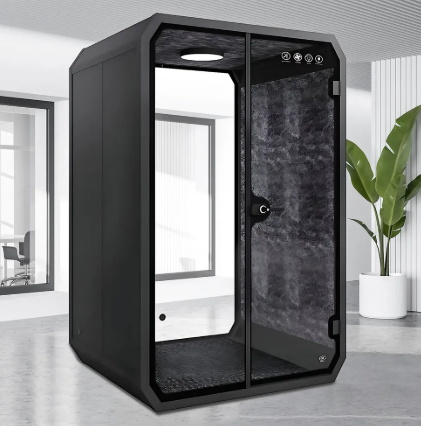With the increasing popularity of telecommuting, many people are beginning to move their office soundproof pods home to create a non-interference and dedicated working environment. These compact and private spaces are very suitable for all kinds of activities, from video calling to deep work. When setting up office cubicles, a common question is whether it is feasible to install monitors in the cubicles. In this article, we will discuss why this is a good idea, provide step-by-step installation techniques, and discuss the key points to ensure that your setup is practical and comfortable.
1. Why should you install a monitor in the cubicle of your home office?
Installing a monitor in an office cubicle can maximize work efficiency.
Office soundproof pods are designed to provide a quiet and undisturbed working environment, and installing a monitor in the cubicle can greatly enhance your experience. The monitor allows you to easily view the computer screen and any digital content without leaving the cubicle. For those who work in a narrow space or seek a cleaner working environment, this may be a game-changing move. Whether you are making a video call, giving a presentation, or focusing on your work, putting the monitor within reach can improve efficiency and help maintain the continuity of your work.
2. Space considerations for installing monitors in office compartments
Measure your cubicle space: find the right position for the monitor.
Before deciding on the size and style of the monitor, you need to measure the available space in your office cubicle. Many compartments are compact in design, and choosing an oversized monitor may make the space appear crowded. You can consider choosing a wall-mounted monitor for small compartments, because this setting can free up desktop space and maximize the functionality of the workspace. In addition, if your cubicle is large, a larger monitor may also be suitable, but always consider ergonomics and available space.
3. Choose the right monitor for your office cubicle.
Choosing the Best Monitor for a Small Office Compartment
When installing a monitor, be sure to choose a monitor that meets both your space requirements and your requirements. Here are some factors to consider:
Screen size and resolution: For small soundproof pods, a monitor between 24 and 27 inches is usually ideal. Look for a high-resolution monitor (1080p or higher) to ensure clear images during video calls or design tasks.
Ultra-thin design: If your cubicle space is limited, consider ultra-thin monitors, which can be mounted on the wall or on a compact stand.
Installation flexibility: Choose a monitor with flexible wall hanging options or adjustable height to ensure ergonomic comfort.
4. Monitor installation: wall-mounted and bracket-mounted.
In the home office cubicle, should you choose wall-mounted installation or bracket-mounted installation?
There are two main ways to install monitors in home office compartments: wall-mounted installation or using brackets. Each method has its advantages, so the final choice depends on your space and needs.
Wall-mounted monitor: Wall-mounted monitor is an excellent choice to save valuable desktop space. This installation method also allows you to better control the height of the monitor, thus reducing neck pressure. However, wall-mounted installation requires careful installation, so please make sure you have the right tools or consider hiring professionals to install it.
Stand-up monitor: If you are more flexible, a stand-up installation may be a better choice. The bracket is easier to install and move, and the position of the screen can be quickly adjusted. Some models are even equipped with a built-in cable management function, which can keep cables in order, which is especially important for small office soundproof pods.
5. Power supply and connectivity: ensure smooth operation.
Manage power and connectivity in a home office cubicle.
When adding monitors to your office cubicle, you need to consider power supply and connectivity. These factors are essential to ensure smooth operation:
Power supply: Make sure your cubicle has enough power outlets, especially if you use other equipment, such as a computer tower, mobile phone charger, or external speakers. You may need to install additional sockets or use extension cords to ensure convenient power access.
Connectivity options: A reliable Internet connection is essential for video calls or collaborative tasks. Make sure that the cubicle can access the Wi-Fi network or Ethernet for a stable connection. In addition, make sure that your monitor has the necessary ports (HDMI, DisplayPort, USB-C) to connect to your computer. Some modern monitors also provide a wireless connection for wireless settings.
6. Sound insulation and audio: enhance your booth experience.
Improve sound and audio quality in your office pods.
Although many home office booths have a sound insulation function, adding monitors may affect the acoustic effect. Many monitors have their own speakers, but they often cannot provide the audio quality needed for an immersive experience or clear video calls.
External speakers or headphones: For better sound effects, it is recommended to use external speakers or noise-reducing headphones. This will greatly enhance the listening experience, especially when you are in a meeting or watching the media.
Sound insulation: Please remember the importance of reducing sound leakage. If external speakers are placed inside the reception room, please adjust their positions carefully to avoid disturbing the quiet atmosphere.
Conclusion: Why is it wise to install a monitor in home office soundproof pods?
In a word, installing a monitor in a home office cubicle can significantly improve the efficiency and comfort of the workspace. You can create a more efficient and pleasant working environment by choosing the appropriate monitor, installation method, and considering factors such as ergonomics and connectivity. Whether you are in a cubicle or a large space, having a dedicated screen allows you to access Tork content quickly and comfortably, making it an indispensable part of home office settings.
How to Optimize an Office Compartment into a Home Office Space: Install a Monitor and Improve the Working Environment

